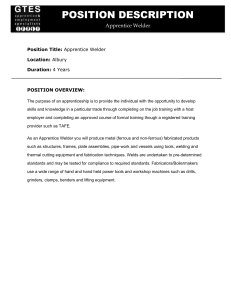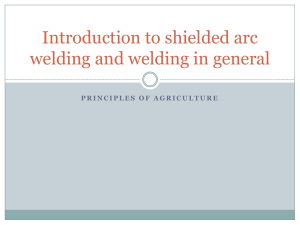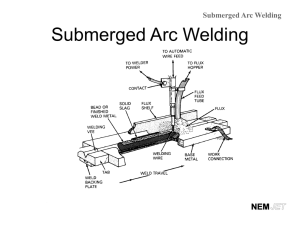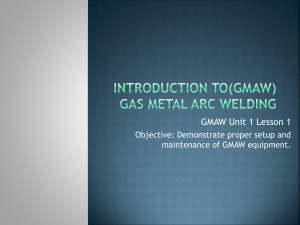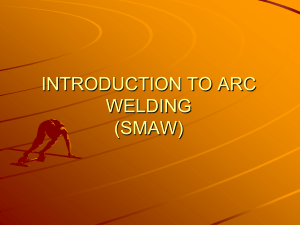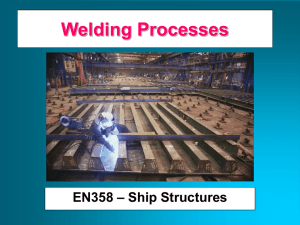ARC WELDING NOTES
advertisement
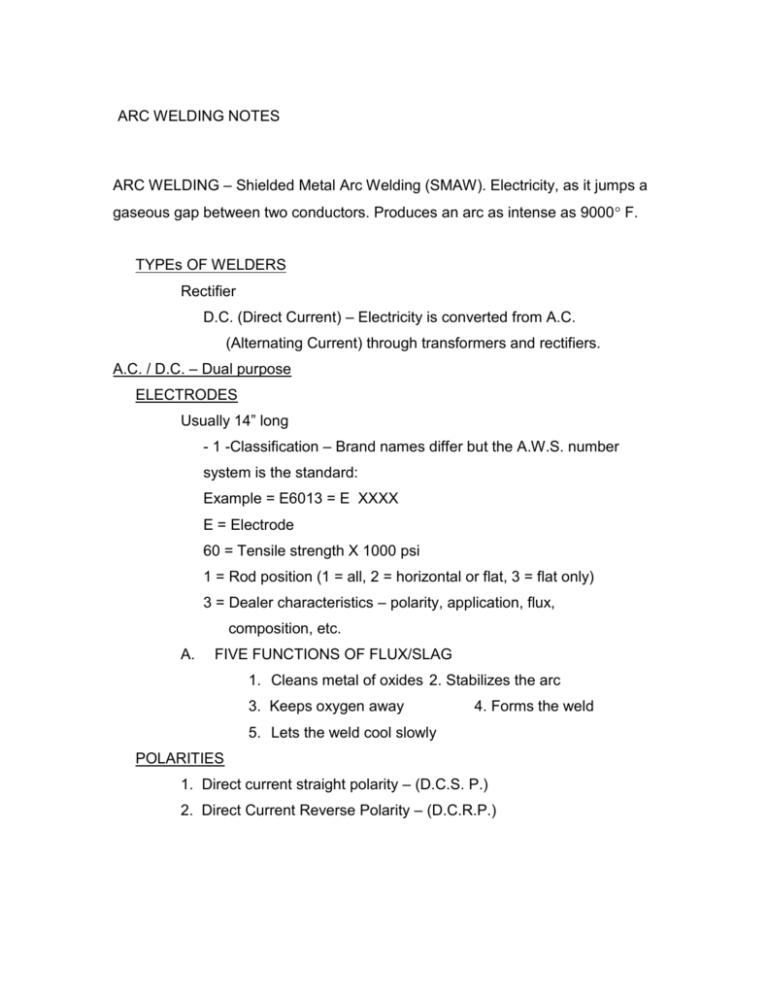
ARC WELDING NOTES ARC WELDING – Shielded Metal Arc Welding (SMAW). Electricity, as it jumps a gaseous gap between two conductors. Produces an arc as intense as 9000 F. TYPEs OF WELDERS Rectifier D.C. (Direct Current) – Electricity is converted from A.C. (Alternating Current) through transformers and rectifiers. A.C. / D.C. – Dual purpose ELECTRODES Usually 14” long - 1 -Classification – Brand names differ but the A.W.S. number system is the standard: Example = E6013 = E XXXX E = Electrode 60 = Tensile strength X 1000 psi 1 = Rod position (1 = all, 2 = horizontal or flat, 3 = flat only) 3 = Dealer characteristics – polarity, application, flux, composition, etc. A. FIVE FUNCTIONS OF FLUX/SLAG 1. Cleans metal of oxides 2. Stabilizes the arc 3. Keeps oxygen away 4. Forms the weld 5. Lets the weld cool slowly POLARITIES 1. Direct current straight polarity – (D.C.S. P.) 2. Direct Current Reverse Polarity – (D.C.R.P.) DCRP flows in one direction also (- to +) but the leads are reversed. 1/3 heat at the base and 2/3 heat at the rod. Characteristics 1. Deep penetration – good for thick metals 2. Prone to arc blow 3. Alternating Current - (A.C.) STRIKING AN ARC – Like striking a match – touch the electrode to the metal, then circle up and back down to the dia. of the rod away from the base metal. Motion - (Avoid excessive movement) A. Straight - Feed in & drag the puddle ROD POSITION Flat – Rod perpendicular to base metal. Incline about 20 from perpendicular toward direction of travel. Drag the weld. (Backhand) Lapp or Inside Corner – Angle rod 30 to 45 to base metal. Incline 20 toward direction of travel. Drag weld. WELD JOINTS Butt joint – prepare joint. Metal must be clean. Always tack & vee thick pieces for penetration. Use a slight motion back & forth. Flange (edge joint) – Always tack. Easiest weld. Thick pieces should be veed. Lapp joint – Very common. Plug, rosette, slot welds are all variations of the lap weld. Concentrate heat on bottom plate. Use a slight weave motion. Always tack. Inside Corner (Tee joint) – Equal weld on each plate. Finished joint should be concave to flat. Use a close arc. Concentrate heat on bottom plate. Always tack. Outside joint – Allow for natural vee. Always tack. Use a slight weave. WELDING POSITIONS Flat Horizontal (on a vertical plane). Vertical Overhead PROBLEMS Arc Blow – A magnetic force deflects the weld into splitting. Cure – Reestablish ground. Shorten arc length. Undercut A trough or erosion cut on either side of the weld. Cure – Turn down heat or shorten arc length or hesitate at the edges to fill in. Rod Sticks Break the circuit or current . Release electrode from the electrode holder. Cure/Cause – Too cold heat setting, too close, not striking it, wrong electrode or wrong polarity. Arc Won’t Start Check out the following Machine set up and switches Check for proper ground Check rod – held in stinger, end glassed over. Welds Splits – mistaken for arc blow – moving rod too fast. Go slower to let it fill in with filler rod. SAFETY Protective equipment – All the listed equipment protects you from heat, splatter and harmful rays. (Ultraviolet & Infrared). Gloves – leather Do not hold hot metal or get them wet. Leather shrinks, burns and hardens. Jacket – leather Not to be used as a shop coat. For arc welding only. Helmet – A full head and face shield Protects head, face, and neck, can be adjusted and has a #10 welding lens. NEVER… Expose skin or eyes to a flash or arc. Misuse equipment – change the amperage setting on the machine while under a load or during the welding process. Chip slag without eye protection. Take a chance with electricity. Weld on the table, booth or anything that is not a project. Exceed the welder’s Duty Cycle – the amount of time the machine can work before it needs to cool down. Example: 70% Duty Cycle at 150 amps = You can weld 7 out of 10 minutes. The duty cycle is 10 minutes from when you start and continues in 10 minute blocks from there on.





